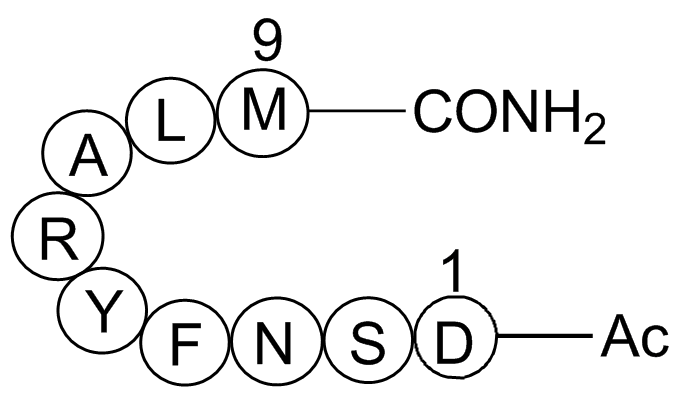Epidermal growth factor receptor (994-1002) acetyl/amide (Synonyms: Ac-Asp-Ser-Asn-Phe-Tyr-Arg-Ala-Leu-Met-amide ) |
| Katalog-Nr.GP10005 |
EGF-family receptor
Products are for research use only. Not for human use. We do not sell to patients.

Sample solution is provided at 25 µL, 10mM.
The epidermal growth factor receptor (EGFR; ErbB-1; HER1 inhumans) is the cell-surface receptor for members of the epidermal growth factor family (EGF-family) of extracellular protein ligands1. EGFR (epidermal growth factor receptor) exists on the cell surface and is activated by binding of its specific ligands, including epidermal growth factor and transforming growth factor ﹡ (TGF﹡). Mutations that lead to EGFR overexpression (known as upregulation) or overactivity have been associated with a number of cancers, including lung cancer, anal cancers and glioblastoma multiforme2. In this latter case a more or less specific mutation of EGFR, called EGFRvIII is often observed. Mutations, amplifications or misregulations of EGFR or family members are implicated in about 30% of all epithelial cancers. Mutations involving EGFR could lead to its constant activation, which could result in uncontrolled cell division - a predisposition for cancer. Consequently, mutations of EGFR have been identified in several types of cancer, and it is the target of an expanding class of anticancer therapies3.
References:
1. Herbst RS (2004). "Review of epidermal growth factor receptor biology". Int. J. Radiat. Oncol. Biol. Phys. 59 (2 Suppl): 21-6.
2. Walker F, Abramowitz L, Benabderrahmane D, Duval X, Descatoire V, H?nin D, Lehy T, Aparicio T (November 2009). "Growth factor receptor expression in anal squamous lesions: modifications associated with oncogenic human papillomavirus and human immunodeficiency virus". Hum. Pathol. 40 (11): 1517-27.
3. Zhang H, Berezov A, Wang Q, Zhang G, Drebin J, Murali R, Greene MI (August 2007). "ErbB receptors: from oncogenes to targeted cancer therapies". J. Clin. Invest. 117 (8): 2051-8.
Average Rating: 5 (Based on Reviews and 30 reference(s) in Google Scholar.)
GLPBIO products are for RESEARCH USE ONLY. Please make sure your review or question is research based.
Required fields are marked with *




















